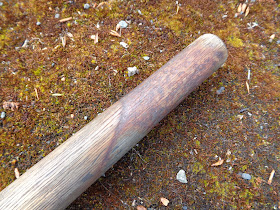Today we'll be taking a look at one of the most unique military entrenching tools that, in my opinion, has ever been issued to an army at war.
This shovel is the Imperial Japanese Army, Type 98, entrenching tool. It may appear to be simple, but as you will see, it is actually quite unique and clever!
Initially, back in 1887, Japan introduced their first entrenching tool. It was a copy of the German, Model 1874, square bladed, feldspaten spade of the time.
In 1888, Japan introduced a round bladed, Engineer's Shovel. This shovel had a removable blade that was held in place with a wooden peg. After a short time of field use, it was soon realized that there were some serious problems with this "peg method" of attaching the handle and blade.
The shovel was redesigned to use rings and a rope to attach the two together, and several handle lengths were trialed.
In 1917, a final design was settled on and the new method of attaching the two parts together was a length of rope, with a hole in the blade corner and a hole in the handle. The wood handle also took on a very "German" style, with a ball end.
After Japan's invasion of China, the Imperial Japanese Army again reevaluated the shovel design. From 1937 - 1938, some very unique changes were made, and the new shovel was designated the Type 98 Entrenching Tool. Starting in 1941, and into 1945, these Type 98 shovels were produced and issued. They were used alongside the earlier versions in the field.
The most obvious change to the Type 98 was the addition of two small "eye holes" in the blade. The handle profile was also changed.
You can read a very detailed history of the Imperial Japanese Army (IJA) entrenching tools here. This reference includes details from the Japanese archives, illustrations, measurements, Japanese terms, and design details that you will not find anywhere else. In short, it's the best I've seen!
http://www.warrelics.eu/forum/japanese-militaria/evolution-japanese-infantrymana-s-entrenching-tool-1887-1945-a-753444/
Before we get started with a detailed look at my shovel, let me point out the most unique features of this entrenching tool. The two "eye holes" and the angled cut to the handle socket on the blade.
These IJA shovel blades were intended for digging, and as a form of personal armor. That's right, armor!
To use the blade as armor, it was removed from the handle and driven vertically into the ground, using the shaft socket as a the "spike".
The soldier could then lay prone, flat on the ground, behind the blade, and use the two eye holes to look through. Getting hit with a rifle round or shrapnel, while looking through the "eye holes" would give a whole new meaning to getting your "bell rung"!
It is interesting to note that while looking through the holes, your nose tucks perfectly into the hollow at the base of the socket. A very unique design to say the least!
My shovel was obtained from an estate liquidation sale down in Southern California. I will never know the story of how it ended up in an old California barn, unfortunately, but it is more than probable that it was used in the Pacific Theater of Operations, the South Pacific Islands, during WW2. These shovels were popular with the British troops, and probably with a few of the US troops as well. It may very well have come home with a US soldier, as a souvenir at the end of the war. Who knows, maybe it was an Iwo Jima or Guadalcanal battlefield pick-up.
My shovel is a combination of a Type 98 blade, and the earlier, 1917 handle style. The original rope is missing, so a display replacement will have to be fabricated.
The shovel blade appears to have had a bit of fire damage on the end portion of the blade, and then was subjected to some rusting after the paint burned off.
The handle was weathered gray, and had seen it's fair share of exposure, and drying.
The only "restoration" that I did to the shovel, was to remove the loose rust from the blade, oil the metal, and apply a nourishing coat of Danish Oil to the wood handle.
My shovel is unmarked, so I compared the weights, and measurements with known originals. Mine matches the measurements perfectly, and the weight was within a gram or two. Perfect match, an original! The replicas that have been produced all weigh significantly less than originals. You can get details on the reference link I provided above.
Before we get into the photo album of my IJA Type 98 shovel, I thought I'd do a little, side-by-side comparison of the Japanese, US, and British entrenching tools. These were the three tools that saw service in the South Pacific Islands. It is easy to see why the British troops often picked up the IJA Type 98 shovels. The small size, and awkward stye, of the British "pick-hoe-shovel", just couldn't compare to the usefulness of the IJA shovel!
The US entrenching tool was similar in style, but lighter and smaller. The US soldiers seemed to prefer their own issue shovels, unlike a number of their British counterparts.
I know this has been a lengthy post, so let's get on with the photo album. Enjoy.


























